《儿科学》课程作业习题(典型病例)07 congenital hypothyroidism
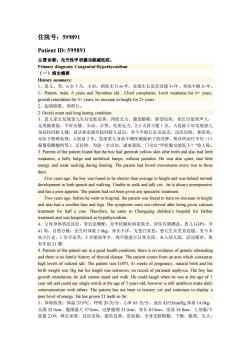
住院号:599891Patient ID: 599891主要诊断:先天性甲状腺功能减低症。Primary diagnosis: Congenital Hypothyroidisn(一)病史摘要History summary1、患儿,男,6岁7月,主诉:四肢无力6+年,发现生长发育迟缓5+年,身高不增2+年1、Patient, male, 6 years and 7monthes old . Chief complaints: Limb weakness for 6+ years,growth retardation for 5+ years, no increase in height for 2+ years2、起病隐匿,病程长2.Occultonset and long lasting condition3、患儿家长发现患儿生后皮肤苍黄,四肢无力,腹部膨隆,脐部包块,家长自觉哭声大,无巩膜黄染,平时安静、少动、少哭,吃奶无力,2-3天排大便1次。入院前5年发现患儿身高较同龄儿矮,说话和走路亦较同龄儿延迟,至今不能行走及说话,反应迟钝,食欲差。未给予特殊处理,入院前2年,发现患儿身高不增伴颜面和下肢浮肿,曾补钙治疗半年(口服葡萄糖酸钙等),无好转,为进一步诊治,遂来我院,门诊以“甲状腺功能低下?"收入院3. Parents ofthe patient found that the boy had geenish yellow skin after birth and also had limbweakness, a belly bulge and umbilical lumps, without jaundice. He was also quiet had litleenergy and weak sucking during feeding. The patient had bowel movements every two to threedavind to be shnd was behind nornsiohondevelopment inbothspeechandwalkingUnabletowalkandtalkyet,heisalwaysunresponsivand has a poor appetite. The patient had not been given any specialist treatment.Two years ago, before he went to hospital, the patient was found to have no increase in heightand also had a swollen face and legsThe symptoms were not relieved after beinggiven calciumheefoehcamChoningchilden'shpialfofurthtreatmenhospitalized as hypothyroidisrreat4、父母身体状况良好,非近亲婚配,无甲状腺疾病家族史,居住区服碘盐。患儿G3P3,孕41周,自然分娩,出生时体重5.0kg,身长不详,无苍白室息。患儿生长发育迟缓,至今未站立行走,1岁可逗笑,5岁能说单字,现不能进行日常交流,未入幼儿园,活动量差。现有牙齿21颗arents of the patient are in a good health condition, there is no evic4Dence of genetic inbreedingand there is nofamily history ofthyroid disease.The patient comesfrom an area which consumeshigh levels of iodized salt. The patient was G3P3, 41 weeks of pregnancy, natural birth and hisbirth weight was 5kg but his length was unknown,norecord of perinatal asphyxiaThe boy hasorowth retardation: he still cannot stand and walk. He could laugh when he was at the age of1year old and could say single words at the age of 5 years old, however is still unable tomake dailyothers.The patier not been to nursery yet and continues to displaypoor level of energy. He has grown 21 teeth so far5、体格检查:体温37.0C,呼吸20次/分,心率81次/分,血压83/53mmHg,体重14.0kg,头围52.0cm,腹围最大57.0cm,过脐腹围53.0cm,身长81.0cm,坐高54.8cm,上部量/部量2.09,神志呆滞,反应迟钝,面色苍黄,贫血貌,全身皮肤粗糙、干燥、脱屑,头大
住院号:599891 Patient ID: 599891 主要诊断:先天性甲状腺功能减低症。 Primary diagnosis: Congenital Hypothyroidism (一)病史摘要 History summary: 1、患儿,男,6 岁 7 月,主诉:四肢无力 6+年,发现生长发育迟缓 5+年,身高不增 2+年。 1、Patient, male, 6 years and 7monthes old . Chief complaints: Limb weakness for 6+ years, growth retardation for 5+ years, no increase in height for 2+ years. 2、起病隐匿,病程长。 2. Occult onset and long lasting condition. 3、患儿家长发现患儿生后皮肤苍黄,四肢无力,腹部膨隆,脐部包块,家长自觉哭声大, 无巩膜黄染,平时安静、少动、少哭,吃奶无力,2-3 天排大便 1 次。入院前 5 年发现患儿 身高较同龄儿矮,说话和走路亦较同龄儿延迟,至今不能行走及说话,反应迟钝,食欲差。 未给予特殊处理,入院前 2 年,发现患儿身高不增伴颜面和下肢浮肿,曾补钙治疗半年(口 服葡萄糖酸钙等),无好转,为进一步诊治,遂来我院,门诊以“甲状腺功能低下?”收入院。 3. Parents of the patient found that the boy had greenish yellow skin after birth and also had limb weakness, a belly bulge and umbilical lumps, without jaundice. He was also quiet, had little energy and weak sucking during feeding. The patient had bowel movements every two to three days. Five years ago, the boy was found to be shorter than average in height and was behind normal development in both speech and walking. Unable to walk and talk yet,he is always unresponsive and has a poor appetite. The patient had not been given any specialist treatment. Two years ago, before he went to hospital, the patient was found to have no increase in height and also had a swollen face and legs. The symptoms were not relieved after being given calcium treatment for half a year. Therefore, he came to Chongqing children’s hospital for further treatment and was hospitalized as hypothyroidism. 4、父母身体状况良好,非近亲婚配,无甲状腺疾病家族史,居住区服碘盐。患儿 G3P3,孕 41 周,自然分娩,出生时体重 5.0kg,身长不详,无苍白窒息。患儿生长发育迟缓,至今未 站立行走,1 岁可逗笑,5 岁能说单字,现不能进行日常交流,未入幼儿园,活动量差。现 有牙齿 21 颗. 4. Parents of the patient are in a good health condition, there is no evidence of genetic inbreeding and there is no family history of thyroid disease. The patient comes from an area which consumes high levels of iodized salt. The patient was G3P3, 41 weeks of pregnancy, natural birth and his birth weight was 5kg but his length was unknown, no record of perinatal asphyxia. The boy has growth retardation; he still cannot stand and walk. He could laugh when he was at the age of 1 year old and could say single words at the age of 5 years old, however is still unable to make daily communication with others. The patient has not been to nursery yet and continues to display a poor level of energy. He has grown 21 teeth so far. 5、体格检查:体温 37.0°C,呼吸 20 次/分,心率 81 次/分,血压 83/53mmHg,体重 14.0kg, 头围 52.0cm,腹围最大 57.0cm,过脐腹围 53.0cm,身长 81.0cm,坐高 54.8cm,上部量/下 部量 2.09,神志呆滞,反应迟钝,面色苍黄,贫血貌,全身皮肤粗糙、干燥、脱屑,头大
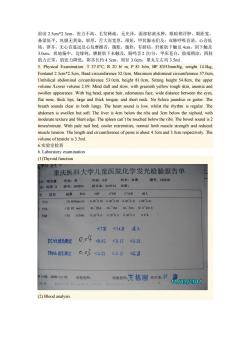
前卤2.5cm*2.5cm,张力不高,毛发稀疏、无光泽,面部粘液水肿,眼脸稍浮肿,眼距宽,鼻梁低平,巩膜无黄染,唇厚,舌大而宽厚,颈短,甲状腺未扪及:双肺呼吸音清,心音低钝,律齐,无心音遥远及心包摩擦音,腹胀,腹软,有脐疝,肝脏肋下触及4cm,剑下触及3.0cm,质地偏中,边缘钝,脾脏肋下未触及,肠鸣音2次/分,甲床苍白,肢端稍凉,四肢肌力正常,肌张力降低:阴茎长约4.5cm,周径3.0cm,睾丸左右均3.5ml.5. Physical Examination: T 37.0°C, R 20 b/ m, P 81 b/m, BP 83/53mmHg, weight 14.0kgrcumference 57.0cm,Fontaleadciroce.52.0cmnumabdomcirUmbilical abdom53.0cm, height 81.0cm, Sitting height 54.8cm, the uppeferencvolume /Lower volume 2.09. Mind dull and slow, with greenish vellow rough skin, anemia ancswollen appearance.With big head, sparse hair, edematous face, wide distance between the eyesflat nose, thickand thick toI short neck.No Sclegoiter.Theips.argnoneart sound is low, whilst theoreathsounoth lungVtThabdomen is swollen but soft The liver is 4cm below the ribs and 3cm below the xiphoid, withmoderate texture and blunt edge. The spleen can't be touched below the ribs. The bowel sound is 2times/minute. With pale nail bed cooler extremities, normal limb muscle strength and reducedmuscle tension.The length and circumferenceeof penis is about 4.5cm and3.Ocm respectively.Thevolume of testicle is 3.5m6.实验室检查6.Laboratory examination(1)Thyroid function重庆医科大学儿童医院化学发光检验报告单标本,血清编号:120505生品验:6岁衣别:特满-11报告单:019741诊断房号:5998成福项目单位849岁914岁结果日E#0.616m/53030.65620.3211082.6157.916080.4427530630365510/m<7岁K14岁成0.048.05放免测定<0-3020.15T8做先测定0.03<0:03<C.50.1卡日期:2009-12-0送检医师检验医师毛栋刚核对者#11/03/2011(2) Blood analysis
前囟 2.5cm*2.5cm,张力不高,毛发稀疏、无光泽,面部粘液水肿,眼睑稍浮肿,眼距宽, 鼻梁低平,巩膜无黄染,唇厚,舌大而宽厚,颈短,甲状腺未扪及;双肺呼吸音清,心音低 钝,律齐,无心音遥远及心包摩擦音,腹胀,腹软,有脐疝,肝脏肋下触及 4cm,剑下触及 3.0cm,质地偏中,边缘钝,脾脏肋下未触及,肠鸣音 2 次/分,甲床苍白,肢端稍凉,四肢 肌力正常,肌张力降低;阴茎长约 4.5cm,周径 3.0cm,睾丸左右均 3.5ml . 5. Physical Examination: T 37.0°C, R 20 b/ m, P 81 b/m, BP 83/53mmHg, weight 14.0kg, Fontanel 2.5cm*2.5cm, Head circumference 52.0cm, Maximum abdominal circumference 57.0cm, Umbilical abdominal circumference 53.0cm, height 81.0cm, Sitting height 54.8cm, the upper volume /Lower volume 2.09. Mind dull and slow, with greenish yellow rough skin, anemia and swollen appearance. With big head, sparse hair, edematous face, wide distance between the eyes, flat nose, thick lips, large and thick tongue, and short neck. No Sclera jaundice or goiter. The breath sounds clear in both lungs. The heart sound is low, whilst the rhythm is regular. The abdomen is swollen but soft. The liver is 4cm below the ribs and 3cm below the xiphoid, with moderate texture and blunt edge. The spleen can’t be touched below the ribs. The bowel sound is 2 times/minute. With pale nail bed, cooler extremities, normal limb muscle strength and reduced muscle tension. The length and circumference of penis is about 4.5cm and 3.0cm respectively. The volume of testicle is 3.5ml. 6.实验室检查 6. Laboratory examination (1)Thyroid function (2) Blood analysis
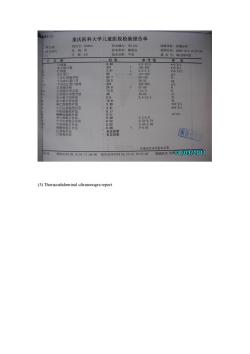
重庆医科大学儿童医院检验报告单E炎病力型摩7-0直名称国国区昌品商#地电理100元婴体贷美高来度e报告已次标本吴活11/03/2011收时间0(3)Thoracoapgrarepo
(3) Thoracoabdominal ultrasonogra report
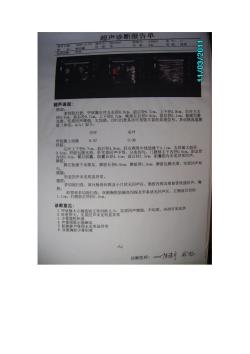
超声诊断报告单林特面车龄:6吉白期:超声表现:多切面扫真,甲状腺左叶左右径0.:8cm剪后径0.7cm,上T免、右叶左叶0.060.07胃状腺上动脉在叶上下餐67%:薛泵篇高8出:肝右镇骨中线助缘下有肝最大斜管.6c0.3肝胜餐磨囊:腊爽展程声中等,门走天染宽高惠脾左肋缘下未探及,脾脏长径6.6cm,脾脏厚1.9cm,脾脏包膜光滑,实质回声均肤膜形态回声未见明显异常。多切面扫查,部分肠曲间探及小片状无回声区。肠腔内探及卷曲管状强回声,胸腔,1.经碁素智需割膏。双侧胸腔肋隔角均探及窄条状无回声区。左侧前后径约英然腾大小塑馈酱恶巢员髓是省活实质回声增强,不均质,内尚可见血供user降流育药格诊断医师:
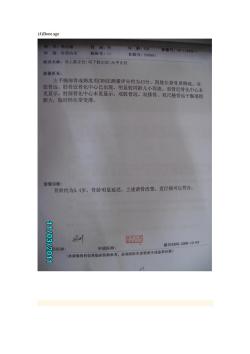
(4)Bone age号CR-11490科别:特需病房病床号:住院号:599891检查名称:双上肢正位|双下肢正位|左手正位影像所见:左手腕部骨成熟度用CHIN法测量评分约为43分。四肢长骨骨质稀疏。双股骨远、胫骨近骨化中心已出现,明显较同龄儿小而淡。双骨近骨化中心未见显示。肘部骨化中心未见显示。双股骨远、双腓骨、双尺桡骨远干髂端稍膨大,临时钙化带变薄。影像诊断:骨龄约为0.4岁。骨龄明显延迟,上述诸骨改变,克汀病可以符合11/03/2011w医园报告时间:2009-12-04青医师:审核医师:(此影像资料仪供临床医师参考,必须经医生亲笔签学或盖章有效)
(4)Bone age
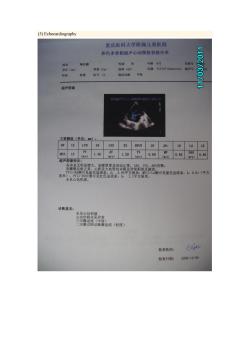
(5) Echocardiography重庆医科大学附属儿童医院彩色多普勒超声心动图检查报告单性刷男年龄6月住院号喻家器a长(cm)体重(kg)印仅器ViVid7-Dimension到10特需临床诊断甲低科休超声图像要满RV12LVD34LVS23RVOT19AO:18LA18MPA151.29P1.36MV0.85DAO0.850.69超声图像物交高及用是提大心藏装奖蓝餐肉梨医效发影流发油0A完餐。LA侧可见蓝色返流束:A:0.91(平可览班爸返流束31平方屏头包积诊断意见志闪给锅梨尖腾爱施动床魔返流(轻度)N2检查医师检查日期:2009-12-05
(5) Echocardiography
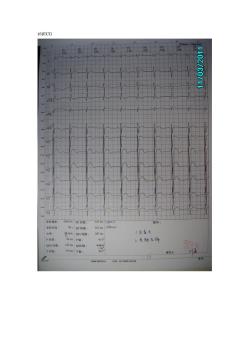
(6)ECGSV4V6R间期8元QT间期351ms右鱼大事QTe闯期2.电轴左仰70T表00000
(6)ECG
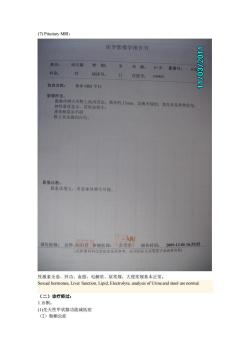
(7) Pituitary MRI:医学影像学报告书LL02/20/L姓名:喻宏鑫性别年龄:6+岁影像号:科室:病床号:特11住院号:599891检查名称:垂体MRI平扫影像所见:是结模态血整上港内突典:高径 13m,边续不规则,共内未见异常信号,垂体显示,其形态较小垂体柄显示不清鞍上未见确切占位影像诊断垂体增大,考虑垂体增生可能光院报告时间:2009-12-0616:55:02报告医师:徐、欧阳普审核医师:彭雪华影信资料仪供中零性激素全套、肝功、血脂、电解质、尿常规,大便常规基本正常。Sexual hormones,Liverfunction,Lipid,Electrolyte,analysis ofUrine and stool are normal(二) 诊疗经过:1.诊断:(1)先天性甲状腺功能减低症(2)肠虫症
(7) Pituitary MRI: 性激素全套、肝功、血脂、电解质、尿常规,大便常规基本正常。 Sexual hormones, Liver function, Lipid, Electrolyte, analysis of Urine and stool are normal. (二)诊疗经过: 1.诊断: (1)先天性甲状腺功能减低症 (2)肠蛔虫症
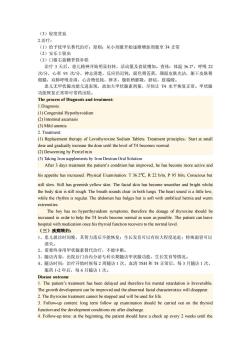
(3)轻度贫血2.治疗:(1)给予优甲乐替代治疗:原则:从小剂量开始逐渐增加剂量至T4正常(2)安乐士驱虫(3)口服右旋糖苷铁补铁治疗3天后,患儿精神开始明显好转,活动量及食欲增加。查体:体温36.2,呼吸22次/分,心率95次/分,神志清楚,反应仍迟钝,面色稍苍黄,颜面皮肤光洁,驱干皮肤稍粗糙,双肺呼吸音清,心音稍低钝,律齐,腹软稍膨隆,脐疝,肢端暖。患儿无甲状腺功能亢进表现,故加大甲状腺素剂量,尽快让T4水平恢复正常。甲状腺功能恢复正常即可带药出院。Theprocess of Diagnosis and treatment:1.Diagnosis(1) Congenital Hypothyroidism(2) Intestinal ascariasis(3) Mild anemia2.Treatment(1) Replacement therapy of Levothyroxine Sodium Tablets. Treatment principles: Start at smallthe dose until thelevel ofT4 becomes normaldoseand gradually(2) Deworming by Pentelmin(3) Taking Iron supplements by Iron Dextran Oral SolutionAfter 3 days treatment the patient's condition has improved, he has become more active anded. Physical Examination: T 36.2℃, R 22 b/m, P 95 b/m, Conscious burhis appetstill slow. Stillyellowskin.TThe facial skin has bnootherandbrightwhilstthe body skin is stilrough The breath sounds clear in both lungs The heart sound is a litle low,while the rhythm is regular. The abdomen has bulges but is soft with umbilical hernia and warmextremitiesThe boy has no hyperthyroidism symptoms therefore the dosage of thyroxine should beto help the T4 levels become normal as soon as possible. The patient can leavencreasedinordhospital with medication once his thyroidfunction recovers tothe normal level.(三)疾病转归:1、患儿就诊时间晚,其智力落后不能恢复;生长发育可以有很大程度追赶;特殊面容可以消失2、需要终身用甲状腺素替代治疗,不能中断。3、随访内容:出院后门诊内分泌专科长期随访甲状腺功能,生长发育等情况,4、随访时间:治疗开始时候每2周随访1次,血清TSH和T4正常后,每3月随访1次,服药1-2年后,每6月随访1次。Disease outcome1.The patient's treatment has been delayed and therefore his mental retardation is rreversibleThesaracteristics willdisappearroelop2.The thyroxine treatment cannot be stopped and will be used for life3. Follow-up content: long tem follow up examination should be caried out on the thyroidfunction and the development conditions etc after discharge4. Follow-up time: at the beginning the patient should have a check up every 2 wecks until the
(3)轻度贫血 2.治疗: (1)给予优甲乐替代治疗:原则:从小剂量开始逐渐增加剂量至 T4 正常 (2)安乐士驱虫 (3)口服右旋糖苷铁补铁 治疗 3 天后,患儿精神开始明显好转,活动量及食欲增加。查体:体温 36.2°,呼吸 22 次/分,心率 95 次/分,神志清楚,反应仍迟钝,面色稍苍黄,颜面皮肤光洁,躯干皮肤稍 粗糙,双肺呼吸音清,心音稍低钝,律齐,腹软稍膨隆,脐疝,肢端暖。 患儿无甲状腺功能亢进表现,故加大甲状腺素剂量,尽快让 T4 水平恢复正常。甲状腺 功能恢复正常即可带药出院。 The process of Diagnosis and treatment: 1.Diagnosis: (1) Congenital Hypothyroidism (2) Intestinal ascariasis (3) Mild anemia 2. Treatment: (1) Replacement therapy of Levothyroxine Sodium Tablets. Treatment principles:Start at small dose and gradually increase the dose until the level of T4 becomes normal. (2) Deworming by Pentelmin (3) Taking Iron supplements by Iron Dextran Oral Solution. After 3 days treatment the patient’s condition has improved, he has become more active and his appetite has increased. Physical Examination: T 36.2℃, R 22 b/m, P 95 b/m, Conscious but still slow. Still has greenish yellow skin. The facial skin has become smoother and bright whilst the body skin is still rough. The breath sounds clear in both lungs. The heart sound is a little low, while the rhythm is regular. The abdomen has bulges but is soft with umbilical hernia and warm extremities. The boy has no hyperthyroidism symptoms; therefore the dosage of thyroxine should be increased in order to help the T4 levels become normal as soon as possible. The patient can leave hospital with medication once his thyroid function recovers to the normal level. (三)疾病转归: 1、患儿就诊时间晚,其智力落后不能恢复;生长发育可以有很大程度追赶;特殊面容可以 消失。 2、需要终身用甲状腺素替代治疗,不能中断。 3、随访内容:出院后门诊内分泌专科长期随访甲状腺功能,生长发育等情况。 4、随访时间:治疗开始时候每 2 周随访 1 次,血清 TSH 和 T4 正常后,每 3 月随访 1 次, 服药 1-2 年后,每 6 月随访 1 次。 Disease outcome 1. The patient’s treatment has been delayed and therefore his mental retardation is Irreversible. The growth development can be improved and the abnormal facial characteristics will disappear. 2. The thyroxine treatment cannot be stopped and will be used for life. 3. Follow-up content: long term follow up examination should be carried out on the thyroid function and the development conditions etc after discharge. 4. Follow-up time: at the beginning, the patient should have a check up every 2 weeks until the
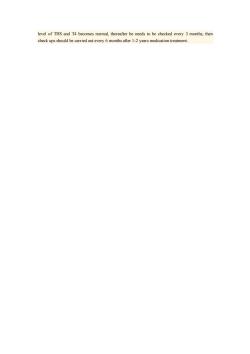
level of THS and T4 becomes normal, thereafter he needs to be checked every 3 months, thencheck ups should be carried outevery 6 months afer1-2 years medication treatment
level of THS and T4 becomes normal, thereafter he needs to be checked every 3 months, then check ups should be carried out every 6 months after 1-2 years medication treatment
按次数下载不扣除下载券;
注册用户24小时内重复下载只扣除一次;
顺序:VIP每日次数-->可用次数-->下载券;
- 《儿科学》课程作业习题(典型病例)05 purulent meningitis.doc
- 《儿科学》课程作业习题(典型病例)04 iron deficiency anemia.doc
- 《儿科学》课程作业习题(典型病例)03 congenital heart disease-VSD.doc
- 《儿科学》课程作业习题(典型病例)08 diarrhea.doc
- 《儿科学》课程作业习题(典型病例)06 anute nepheritis-1.doc
- 《儿科学》课程作业习题(典型病例)06 nephrotic syndrome-2.doc
- 《儿科学》课程作业习题(复习题)01 questions of children healthcare.doc
- 《儿科学》课程作业习题(复习题)02 questions of neonatal diseases.doc
- 《儿科学》课程作业习题(复习题)05 questions of blood disorders.doc
- 《儿科学》课程作业习题(复习题)04 questions of circulatory system.doc
- 《儿科学》课程作业习题(复习题)03 questions of respiratory diseases.doc
- 《儿科学》课程作业习题(复习题)06 questions of nervous system.doc
- 《儿科学》课程作业习题(复习题)10 questions of infectious diseases.doc
- 《儿科学》课程作业习题(复习题)09 questions of endocrine disorders.doc
- 《儿科学》课程作业习题(复习题)07 questions of urinological system.doc
- 《儿科学》课程作业习题(复习题)08 questions of immune system.doc
- 《儿科学》课程教学资源(授课教案)12 Acute Glomerulonephritis,Nephrotic Syndrome.doc
- 《儿科学》课程教学资源(授课教案)11 Acute Convulsion in Children.doc
- 《儿科学》课程教学资源(授课教案)13 Immunodeficiency.doc
- 《儿科学》课程教学资源(授课教案)10 Nutritional Iron Deficiency Anemia.doc
- 《儿科学》课程作业习题(典型病例)03 congenital heart disease-TOF.doc
- 《儿科学》课程作业习题(典型病例)01 ABO incompatibility of neonates.doc
- 《儿科学》课程作业习题(典型病例)02 pneumonia.doc
- 《儿科学》课程作业习题(试卷和答案)双语试卷C卷(试题).doc
- 《儿科学》课程作业习题(试卷和答案)双语试卷B卷(试题).doc
- 《儿科学》课程作业习题(试卷和答案)双语试卷B卷(答案).doc
- 《儿科学》课程作业习题(试卷和答案)双语试卷C卷(答案).doc
- 《儿科学》课程作业习题(试卷和答案)双语试卷A卷(试题).doc
- 《儿科学》课程作业习题(试卷和答案)双语试卷A卷(答案).doc
- 《儿科学》课程教学课件(PPT讲稿)07 新生儿缺氧缺血性脑病 Hypoxic-ischemic Encephalopathy(HIE).pptx
- 《儿科学》课程教学课件(PPT讲稿)06 新生儿败血症 Neonatal Septicemia.pptx
- 《儿科学》课程教学课件(PPT讲稿)21 Chronic Gastritis in Children.pptx
- 《儿科学》课程教学课件(PPT讲稿)20 Toxic Bacillary Dysentery.pptx
- 《儿科学》课程教学课件(PPT讲稿)27 Inflammation Causes Cholesterol Redistribution by Diverting Cholesterol from Circulation to Tissue Tompartments.pptx
- 《儿科学》课程教学课件(PPT讲稿)26 Rotavirus Infection in Children.pptx
- 《儿科学》课程教学课件(PPT讲稿)25 Scarlet Fever.pptx
- 《儿科学》课程教学课件(PPT讲稿)24 Mumps(Epidemic parotitis).pptx
- 《儿科学》课程教学课件(PPT讲稿)23 Infantile Hepatitis Syndrome.pptx
- 《儿科学》课程教学课件(PPT讲稿)22 Infantale Diarrhea and Fluid Therapy.pptx
- 《儿科学》课程教学课件(PPT讲稿)19 Pediatric Tuberculosis.pptx
